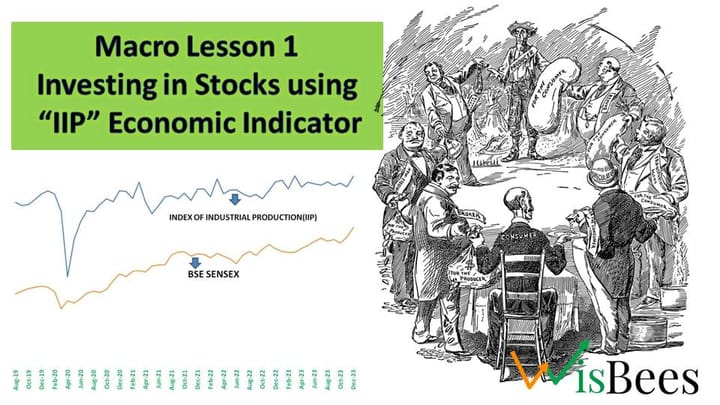"Marico Ltd: A Comprehensive EIC Analysis | Mastering Fundamental Analysis"

“While this article may be a bit lengthy, we've endeavoured to provide a neutral perspective on a stock and educate you on fundamental analysis. Stick with us for some valuable insights! We are not a SEBI registered advisor, and this should be considered as a research case study only."
Once upon a time, there was a man named Ramu who was interested in investing in the stock market. However, he noticed that many people tend to focus solely on the stock price rather than understanding the underlying business. He realized that understanding the business, which is known as fundamental analysis, was not just a game for finance professionals but something that anyone could learn.
Ramu was just an average person with a normal IQ, but he knew that he could understand the basics of a company's business and financials. He learned that this process of analyzing a company and making informed buy or sell decisions was commonly referred to as "Equity Research."
Ramu also discovered that investing for the long term was the best way to create wealth, rather than just trading. By analyzing good businesses, the probability of making money was high because market volatilities were averaged out over time.
So, Ramu decided to learn the technique of analyzing a business fundamentally, which included three steps known as the famous "EIC" approach. The "E" stood for Economic analysis, where he learned about macroeconomic indicators such as GDP growth, inflation, and interest rates. The "I" stood for Industry analysis, where he assessed market size, competition, growth potential, and regulatory environment. The "C" stood for Company analysis, where he looked at financial statements, management team, competitive positioning, and growth prospects.
By following the EIC approach, Ramu was able to gain a comprehensive understanding of a company's potential for growth and profitability, as well as broader economic and industry trends that may impact its performance. With this knowledge, he made informed decisions about whether to invest in a particular stock, hold onto existing investments, or sell his positions.
In the end, Ramu learned that investing in the stock market was not as complicated as it seemed. By using fundamental analysis and the EIC approach, he was able to make informed investment decisions and create wealth for himself over the long term. The story is over. Let's now discover what Ramu has gleaned from his experiences.
Today, we will focus on Marico Ltd, a company in the FMCG sector, and perform an "EIC" analysis to determine whether the stock holds significant value.
Marico Ltd
The EIC approach, which involves Economic, Industry, and Company analysis, is often referred to as the Top-down approach. When preparing a report, I place equal emphasis on the Economy and Industry analysis, accounting for 50% of the report, and the Company analysis, which also accounts for 50%. By conducting an “EI” analysis, we can gain insights into the broader economic and industry trends that impact companies in the same direction.
Remember:- While analysing any business, the first source of information should be its annual reports. If read properly can give you a lot of insight into the business.
Economic Analysis:-
For Marico Ltd, there can be various economic factors such as GDP growth, Inflation and Interests which affect the consumer spending pattern. However, we have to prioritize a few things that affect an FMCG company like Marico are:-
- Inflation in edible oil and crude-based raw materials
- Consumer Demand and Sentiment in Rural and urban markets
When the prices of the raw materials increase due to inflation, it can increase Marico's production costs, which can lower the company's profitability. Recently we published an article regarding the same how declining palm oil prices can improve margins(how much profit a company makes after deducting the costs). Here is the link.

The image above clearly shows that the main products contributing to Marico's revenue are hair oils (primarily coconut oils) and edible oils. A company's stock price is likely to increase if it has a good profit margin and net profit growth. During this quarter, Marico's Parachute coconut oil segment showed good volume growth along with a healthy gross margin (a 2.94% increase YoY) due to the reduced price of copra, its main raw material. Copra is the dried kernel of the coconut and a crucial ingredient in Parachute Coconut Oil. Copra constitutes 40% of the total raw material of Marico. A healthy crop of copra can positively impact Marico's prices. Therefore, by monitoring copra prices, you can get an idea of Marico's financial performance.
Likewise, in the case of Edible Oil, although the prices of raw materials like Rice Bran and Soybean did not decline significantly, Marico Ltd made essential price adjustments, which helped to maintain their margin in this segment.

The second factor we discussed is the impact of rural and urban consumption on the FMCG sector. Rural consumption accounts for approximately 35%-40% of sales in India, making it a crucial contributor to FMCG company revenues. The recent decline in rural demand has posed challenges for the sector, necessitating a closer examination of the factors influencing rural consumption. However, it is anticipated that rural consumption will improve as elections approach in 2024. Historically, the government has implemented numerous initiatives for rural development prior to elections, which have a positive impact on rural consumption. Additionally, the monsoon season plays a significant role in enhancing rural consumption. But in overall picture the Rural consumption is increasing every year for India.
Industry Analysis:-
This is about the industry that the company belongs to and how it affects the company. You need to look at things like trends, opportunities, challenges, competition, etc.
Based on data from IBEF, the FMCG sector in India is projected to achieve a remarkable compound annual growth rate (CAGR) of 27.9%, surpassing the growth rates of most of the sectors. This growth can be attributed to the rising number of online users and the flourishing e-commerce industry, driven by the widespread availability of the internet and smartphones. When an industry experiences growth, companies within that sector tend to benefit as well. Marico, recognising this opportunity, has proactively expanded its presence in numerous rural villages by leveraging its extensive network of stockists.
In the past, the FMCG sector witnessed a decline in market share for various unorganised players. This shift can be attributed to the changing preferences of urban customers, who increasingly prefer the convenience of online supermarkets and grocery shopping. As a result, the traditional unorganised players in the FMCG sector have experienced a reduction in their market share and favoured Marico, like FMCG majors.
Apart from this, growing disposable income and urbanisation will positively impact the FMCG industry.
Company Analysis
This next step of fundamental analysis is perhaps the most crucial - we dive into the inner workings of the business and evaluate the strength of its financials. And speaking of businesses, you might have heard the buzz about Alia Bhatt becoming the brand ambassador for Nihar Shanti Amla. So, let's learn how to conduct a comprehensive company analysis. And the best place to start? The company's annual report, of course!
Let's delve into how Marico's business is performing.
To gain a deeper understanding, it is essential to ask yourself a series of targeted questions. These questions serve as a framework for analysis and provide valuable insights.
- What is the core business of the company?
- What is the product portfolio? -( To know their market presence)
- What is the composition of the company's revenue mix? Which product generates the highest sales volume?
- What type of raw materials are necessary for the company's operations?-(To know the dependency of the company)
- Which companies are the main competitors of the organization?-(To understand peer pressure on margins of the product)
- Who are the promoters, and how much stake they have? -( An increasing and stable promoter’s stake indicates a growing business)
Applying them on Marico:-
- In the Economic analysis, we have seen that Marico is primarily engaged in the production and sale of hair care products, edible oils, and other consumer products in the FMCG industry.
- Some of the main products manufactured by Marico include:
- The categories of Coconut hair oil and Value-added hair oil collectively contribute approximately 68% of Marico's total revenue. These two categories hold significant importance in Marico's product portfolio and play a substantial role in driving the company's overall financial performance.

Marico holds a dominant position in the hair oil category, capturing a significant market share of over 35% in the Indian hair oil market. This leadership position underscores Marico's strong presence and the trust placed in its hair oil brands by consumers across the country.

- The raw materials used are mostly Copra, Edible Oils and Crude Oil Derivatives(for personal care products). We have already discussed this.
- The promoters of Marico have consistently maintained a stake of 59% or above for a significant period, showcasing remarkable stability in their ownership. This consistent and substantial stake held by the promoters highlights their long-term commitment and confidence in the company's growth prospects.
In addition to the aforementioned factors, it is also essential to explore the "Management Discussion" section in the annual report. This section provides valuable insights into the management's strategic planning and outlook for the company.
Analysing Financials
Below are a few things one have to look for while analysing financials:-
Revenue and Profit Growth:-
When we analyze Marico's sales growth rate through a line chart, we observe a cyclic pattern in its revenue growth. While it is true that the FMCG sector is typically non-cyclical and experiences consistent demand, Marico's specific sales growth rates exhibit periodic fluctuations. This suggests that the company's growth rates go through cycles, with periods of slower growth followed by periods of accelerated growth. But a company analysis is not complete untill you compare them with peers.

Hindustan Unilever(HUL) seems to be the fastest growing in sales followed by Marico. It is important to note that despite these cyclic patterns, Marico continues to experience overall growth due to the strong demand for its products. This observation provides a positive outlook as it suggests that the sales growth is currently at a bottom stage, implying that it may start picking up again in the future. But if we compare this growth Hindustan Unilever’s growth it the sales growth in Hindustan Unilever is higher.
GPM, OPM, NPM:-
These profitability ratios provide valuable insights into the company's financial performance, highlighting its operational efficiency and overall profitability. The company's Gross Profit Margin (GPM) stands impressively at 47.41%, indicating its ability to generate substantial profits after accounting for the cost of goods sold. The Operating Margin(OPM ) is at 17.54%, and Net Profit Margin(NPM) is at 13.62%. However, we have to compare these numbers with other peer companies and we can see HUL, Godrej and Colpal are better at their operational efficiencies.
Debt:-
This can be checked from the balance sheet. But it is better to find the Debt to Equity ratio to find see the comparison.

You can see the company has negligible debt, and it’s been steady almost, which signifies the company is not in any financial distress. Although most of the leading FMCG companies do have a similar Debt to Equity curve having almost zero debt ex: HUL, ITC etc.
Receivables/Sales:-
Sometimes companies manipulate their sales by increasing Receivables data. So increasing receivables/sales data can be questionable.

The image above demonstrates the upward trend of Marico's Trade Receivables, indicating that the company is making more credit sales compared to Hindustan Unilever and Godrej Consumer. Although the current data is not particularly encouraging, there's a silver lining for Marico. The recent capital expansion of 132 Crore has the potential to reduce the company's Debt-to-Equity (D/E) ratio by boosting sales. This strategic move aims to improve the company's financial position and could have a positive impact on its overall leverage.
Cash flow from Operations :-
The company has strong positive cash flow operations, which is the most important indicator for an investor to know whether the company is making profits out of its operations or from other activities.
ROE and ROCE:-
A good Return on Equity above 20% is generally preferred by Investors. A company with high ROE and low debt seems ideal for investment.

This image is from Screener. in which you can see the company's 5-year ROE growth is 37%, whereas the company’s stock price has only appreciated by 11%. The ROCE of the company stands at 43.7%, which is again higher than most of its peers.
Valuations:-
Marico's PE ratio stands at a relatively lower level compared to its peers, at 53.3. In contrast, HUL and Nestle are trading at significantly higher PE valuations. While the price-to-book value for Marico appears to be relatively high, with the stock trading at 18 times its book value, it is worth noting that this is not uncommon for FMCG companies.
Disclaimer:-
We are not a SEBI registered Investment Advisor. This is not a recommendation but only a case of sample analysis that might help you to do fundamental research on various companies.
Conclusion:-
Based on this equity research, the company is considered investible due to several factors. Firstly, it exhibits strong cash flows, indicating its ability to generate substantial operating cash from its business activities. Additionally, the company boasts impressive Return on Equity (ROE) figures, indicating efficient utilization of shareholder investments to generate profits. Furthermore, the company's leadership position in the hair oil industry, which contributes to 68% of its revenue, adds to its attractiveness as an investment opportunity.
Technical Tadka:-
Please note that this additional analysis of price is not part of the Equity Research. Consider it as supplementary information that can complement your investment rationale. It provides further insights into the pricing dynamics that may be relevant for your investment decision-making process.

Take a look at this weekly chart of Marico, where we observe a consistent trend of the stock finding support at its 200-day Exponential Moving Average (EMA). Moreover, the stock has recently broken out of a consolidation wedge pattern, indicating the potential for a further rally. This technical analysis suggests a positive outlook for the stock's price movement in the near future.
| Broker | Type | Offerings | Invest |
|---|---|---|---|
 |
Discount Broker | Mutual Funds, Stocks, IPOs, Bonds | Know more |
 |
Discount Broker | Mutual Funds, Stocks, IPOs, Bonds | Know more |
 |
Discount Broker | Mutual Funds, Stocks, IPOs, Bonds | Know more |
 |
Service Broker | Mutual Funds, Stocks, IPOs, Bonds | Know more |



